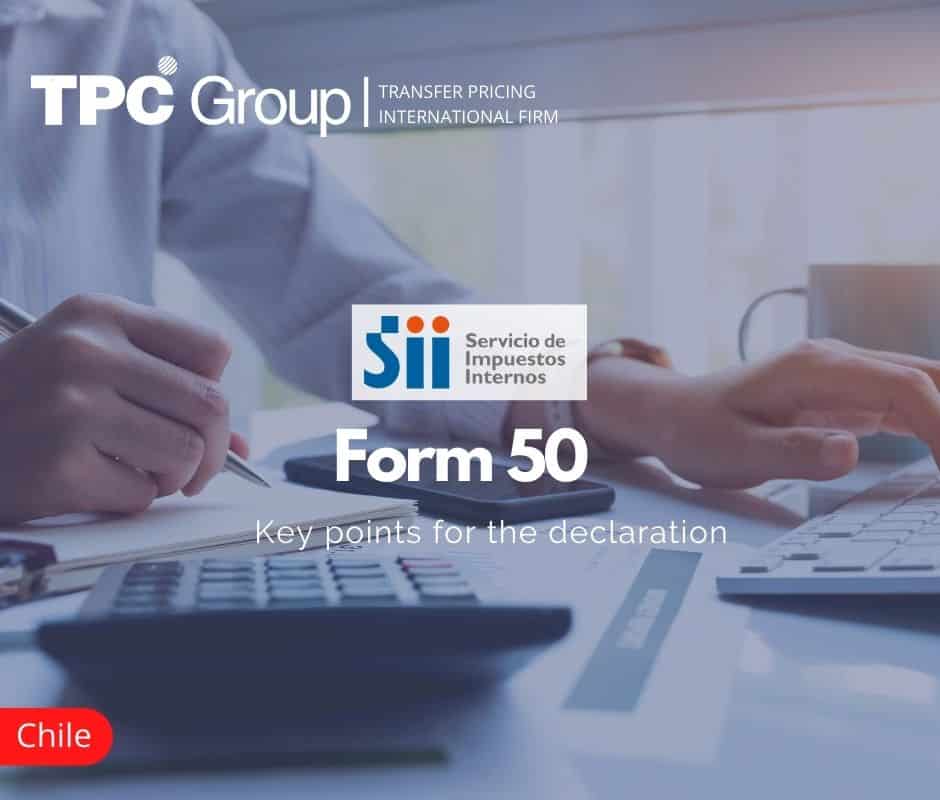In 2001, the Chilean tax system incorporated Form 50, created by the SII (Servicio de Impuestos Internos – Internal Revenue Service) through Exempt Resolution No. 27. The purpose of this form is the monthly statement and simultaneous payment of different taxes established in this country.
Over the years up to the present, its structure and design have been modified through different resolutions issued by the Tax Administration, such as Resolutions Ex. SII No. 87 of September 08, 2004, No. 94 of September 23, 2005, No. 27 of February 25, 2009, No. 78 of May 28, 2009, No. 144 of August 31, 2010, No. 41 of March 29, 2011, No. 10 of January 23, 2013, No. 9 of January 22, 2014, No. 69 of July 21, 2014, and No. 128 of December 31, 2014.
This article clarifies certain doubts that taxpayers may have regarding their tax returns through Form 50
What taxes must be declared in the Monthly Statement and Simultaneous Payment Form 50?
According to the aforementioned provisions, new taxes that can be declared and paid through this form have been introduced in said amendments, being currently all of the following:
|
No. Line Form 50 |
Concept |
|
1 to 42 |
Additional Income Tax |
| 43 |
Specific Tax on the 1st Sale of Diesel Oil |
|
44 |
Specific Tax on the 1st Sale of Automotive Gasolines |
| 45 |
Specific Tax on the 1st Sale of 97 Octane Automotive Gasoline |
|
46 |
Tax on Compressed Natural Gas Vehicles |
| 47 |
Tax on Liquefied Oil Gas Vehicles |
|
48 |
Horse Betting |
| 49 |
Gambling Tax |
|
50 |
Casino Entrance Tax |
| 51 |
Tax 20% of gross revenues of casinos |
|
52 |
Single Tax on Unrestricted Surplus Withdrawals |
| 53 |
Tax established in Article 42 bis N° 3 of the Income Tax Law is withheld by the Insurance Company in case of the death of the insured. |
|
54 |
Single Second Category Tax in cases the employer or payer is exempted from withholding. |
| 55 |
Single Income Tax |
|
56 |
First Category Sporadic Income |
| 57 |
Donation tax |
|
58 |
Sporadic income from sales or transfers of underlying assets located in Chile. |
| 59 |
Difference between nominal and placement values of debt instruments. |
|
60 |
Withholding interest accrued on debt instruments of 104 Income Tax Law. |
| 61 |
Monthly Provisional Payment First Category Art. 84 and mining patent credit. |
|
62 |
Monthly Provisional Payment for technical assistance and Voluntary MPP. |
| 63 |
Tax period refund of income refund |
|
64 to 66 |
Tobacco Tax |
| 67 to 69 |
Ad-Valorem Free Trade Zone |
|
70 |
ENAP (Empresa Nacional del Petróleo – National Oil Company) exploitation right |
|
71 |
Specific Tax Art. 43 ter, Law 18.892 Class A fishing license. |
| 72 |
Substitute tax on accrued income, taxpayers subject to First Category tax under a balance sheet, according to accounting. |
|
73 |
Substitute tax on accrued income |
How does the taxpayer file the statement through Form 50?
The Form 50 statement may be filed through electronic or physical means.
In the case of electronic means, it may be filed through the Internet and the payment through online, agreement payment, or coupon payment. In the latter case, the taxpayer must print two copies of the coupon and go to a financial entity.
Regarding the physical means, it must be filed on paper in a format obtainable at the offices of the SII (Servicio de Impuestos Internos – Internal Revenue Service). Likewise, it may be filed on business days at banks, financial, and authorized institutions.
What is the procedure to file a Form 50 statement through the Internet?
If the taxpayer files the Form 50 statement through the Internet, he/she must have a Tax Code registered in the SII systems.
With this password, the taxpayer may access the SII website (www.sii.cl), locate the Online Services section, go to the “Monthly Taxes” menu, and click on Monthly Statement (F50).
After that, the option to file and pay Form 50 must be selected, which will ask the taxpayer to authenticate with the aforementioned Tax Code and RUT (Registro Único Tributario – Single Tax Registration) or Digital Certificate.
Once this option is accessed, the tax period to be declared must be selected “year and month” and press the “Enter New Data” button.
Once the form is located on the screen, it can be completed with the information related to the tax to be declared, having the options of “Send Statement”, “Save Form”, and “Clear Form” depending on what the user wishes to do.
If you wish to declare when you press the “Send Statement” button, a message should appear indicating that no logical or mathematical error has been made, proceeding with the tax payment.
Subsequent to the tax payment, a digital filing certificate may be obtained.
How can I consult about the Form 50 filed?
There are three ways the taxpayer can consult the status of Form 50 through the SII website, by contacting the “Telephone Help Desk” of the SII and by going to some of the Taxpayer Information and Assistance Centers.
If it is performed through the website, you must enter the website thereof in its online section, monthly taxes menu, option “consultation and follow-up (F29 and F50).
What are the sanctions for late filing of taxes declared through Form 50?
Infringements and penalties for late filing of tax returns are regulated in Article 97 of the Chilean Tax Code. The sanctions by type of tax are detailed below:
|
No. Line Form 50 |
Concept |
Infraction |
|
1 to 42 |
Additional Tax | 97 N° 11 |
| 43 | Specific Tax on the 1st Sale of Diesel Oil |
97 N° 2 par.1° |
|
44 |
Specific Tax on the 1st Sale of Automotive Gasolines | 97 N° 2 par.1° |
| 45 | Specific Tax on the 1st Sale of 97 Octane Automotive Gasoline |
97 N° 2 par.1° |
|
46 |
Tax on Compressed Natural Gas Vehicles | 97 N° 2 par.1 |
| 47 | Tax on Liquefied Oil Gas Vehicles |
97 N° 2 par.1 |
|
48 |
Horse Betting | 97 N° 2 par.1 |
| 49 | Gambling Tax |
97 N° 11 |
|
50 |
Casino Entrance Tax | 97 N° 11 |
| 51 | Tax 20% of gross revenues of casinos |
97 N° 11 |
|
52 |
Single Tax on Unrestricted Surplus Withdrawals | – |
| 53 | Tax established in Article 42 bis N° 3 of the Income Tax Law is withheld by the Insurance Company in case of the death of the insured. |
97 N° 2 par. 1 |
|
54 |
Single Second Category Tax in cases where the employer or payer is exempted from withholding. | 97 N° 2 par. 2 |
| 55 | Single Income Tax |
97 N° 11 |
|
56 |
First Category Sporadic Income | 97 N° 2 par. 1 |
| 57 | Donation tax |
97 N° 2 par. 1 |
|
58 |
Sporadic income from sales or transfers of underlying assets located in Chile. | 97 N° 2 par. 1 |
| 59 | Difference between nominal and placement values of debt instruments. |
97 N° 11 |
|
60 |
Withholding interest accrued on debt instruments of 104 Income Tax Law. | 97 N° 11 |
| 61 | Monthly Provisional Payment First Category Art. 84 and mining patent credit. |
97 N° 11 |
|
62 |
Monthly Provisional Payment for technical assistance and Voluntary MPP. | – |
| 63 | Tax period refund of income refund |
97 N° 11 |
|
64 to 66 |
Tobacco Tax | 97 N° 2 par. 1 |
| 67 to 69 | Ad-Valorem Free Trade Zone |
97 N° 11 |
|
70 |
ENAP (Empresa Nacional del Petróleo – National Oil Company) exploitation right | 97 N° 2 par. 1 |
| 71 | Specific Tax Art. 43 ter, Law 18.892 Class A fishing license. |
97 N° 2 par. 1 |
|
72 |
Substitute tax on accrued income, taxpayers subject to First Category tax under a balance sheet, according to accounting. | – |
| 73 | Substitute tax on accrued income |
– |
In the case of infractions typified in numeral 11 of Article 97, these are fined 10% of the taxes owed.
Concerning the infractions typified in paragraph 1 of numeral 2 of Article 97, these are fined 10% of the taxes resulting from the liquidation, provided that such delay or omission does not exceed 5 months.
Regarding paragraph 2 of this same numeral, this will be fined one tax unit per month to one tax unit per year.
Likewise, it should consider the taxes of lines 1 to 42, 49, 50, 55, 67, and 69 of Form 50 are due on the twelfth day following the month the tax was withheld.
Whereas lines 43, 44, and 45 have the legal deadline for filing the first 10 working days following the week in which the transfers were made.
The single tax on programmed unrestricted surplus withdrawals of the pension funds (No. 52) is the only one without any sanction up to date.
Concerning the aforementioned, taxpayers are advised to file their statements properly and within the deadlines through Form No. 50 to avoid any tax contingency.




